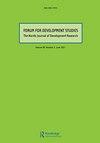Critiquing the SDG Framework Through the Lens of Goal Two: Empirical Reflections from Two Case Studies in India
IF 1.1
Q3 DEVELOPMENT STUDIES
引用次数: 1
Abstract
Abstract Theoretically, much skepticism has emerged insofar as the translation of SDG framework at local level is concerned. Comparatively, much less has been done to investigate the empirical reality of this discourse. Using case study exploration technique situated in two urban areas of India – Mumbai and Sitamarhi, this paper explicates how key contentions of the debate manifest at the ground level. Reflections from Mumbai show that SDG’s reliance on targets and indicators masks extreme inequality underlying so-called ‘extraordinary’ achievements in reducing child stunting. Despite its transformatory claims the operationalization of SDG framework adopts a narrow view on inequality and bypasses related structural processes. At the same time, preoccupation with numbers and targets while implementing nutrition programmes for SDG two in the town of Sitamarhi, distorts the reality and diverts priorities away from systemic issues like infrastructural and institutional gaps. SDG framework’s continued engagement with indicators, targets and numbers, indeed hides multiple axes of inequality in nutrition outcomes, creates fallacious claims of successes and therefore, closes the window for potential improvement. Eventually, both Mumbai and Sitamarhi, despite their development contrast, are faced with similar question – what structural and institutional transformation, must precede the operationalization of SDG two?从目标二的视角批判可持续发展目标框架——来自印度两个案例研究的经验反思
摘要从理论上讲,就地方层面的可持续发展目标框架的翻译而言,出现了许多质疑。相比之下,研究这篇文章的实证现实的工作要少得多。本文利用位于印度孟买和西塔马里两个城市地区的案例研究勘探技术,阐述了辩论的关键论点是如何在地面上表现出来的。孟买的反思表明,可持续发展目标对目标和指标的依赖掩盖了在减少儿童发育迟缓方面取得的所谓“非凡”成就背后的极端不平等。尽管其主张具有变革性,但可持续发展目标框架的实施对不平等问题采取了狭隘的看法,并绕过了相关的结构过程。与此同时,在西塔马里镇实施可持续发展目标二的营养计划时,对数字和目标的关注扭曲了现实,并将优先事项从基础设施和体制差距等系统性问题上转移开。可持续发展目标框架对指标、目标和数字的持续参与,确实隐藏了营养结果不平等的多个轴,创造了错误的成功主张,因此关闭了潜在改善的窗口。最终,孟买和西塔马里都面临着类似的问题——在实现可持续发展目标二之前,必须进行什么样的结构和制度转型?
本文章由计算机程序翻译,如有差异,请以英文原文为准。
求助全文
约1分钟内获得全文
求助全文
来源期刊

FORUM FOR DEVELOPMENT STUDIES
DEVELOPMENT STUDIES-
CiteScore
1.80
自引率
14.30%
发文量
24
期刊介绍:
Forum for Development Studies was established in 1974, and soon became the leading Norwegian journal for development research. While this position has been consolidated, Forum has gradually become an international journal, with its main constituency in the Nordic countries. The journal is owned by the Norwegian Institute of International Affairs (NUPI) and the Norwegian Association for Development Research. Forum aims to be a platform for development research broadly defined – including the social sciences, economics, history and law. All articles are double-blind peer-reviewed. In order to maintain the journal as a meeting place for different disciplines, we encourage authors to communicate across disciplinary boundaries. Contributions that limit the use of exclusive terminology and frame the questions explored in ways that are accessible to the whole range of the Journal''s readership will be given priority.
 求助内容:
求助内容: 应助结果提醒方式:
应助结果提醒方式:


